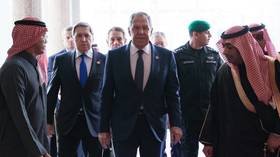Gaddafi’s Ghosts: Return of the Libyan Jamahiriya

When NATO murdered Gaddafi and blitzed his country in 2011, they hoped the socialist ‘Jamahiriya’ movement he led would be dead and buried. Now his son has been released from prison to a hero’s welcome with his movement increasingly in the ascendancy.
There were various moments during NATO’s destruction of Libya that were supposed to symbolically crown Western supremacy over Libya and its institutions (and, by implication, over all African and Arab peoples): the ‘fall of Tripoli’ in August 2011; Cameron and Sarkozy’s victory speeches the following month; the lynch-mob execution of Muammar Gaddafi that came soon after. All of them were pyrrhic victories - but none more so than the death sentence handed down to Gaddafi’s son (and effective deputy leader) Saif al-Gaddafi in July 2015.
Saif had been captured by the Zintan militia shortly after his father and brother were killed by NATO’s death squads in late 2011. The ‘International’ Criminal Court – a neocolonial farce which has only ever indicted Africans – demanded he be handed over to them, but the Zintan – fiercely patriotic despite having fought with NATO against Gaddafi – refused. Over the next two years the country descended into the chaos and societal collapse that Gaddafi had predicted, sliding inexorably towards civil war.
By 2014, the country’s militias had coalesced around two main groupings – the Libyan National Army, composed of those who supported the newly elected, and mainly secular, House of Representatives; and the Libya Dawn coalition, composed of the militias who supported the Islamist parties that had dominated the country’s previous parliament but refused to recognize their defeat at the polls in 2014. After fierce fighting, the Libya Dawn faction took control of Tripoli. It was there that Saif, along with dozens of other officials of the Jamahiriya – the Libyan ‘People’s State’ which Gaddafi had led – were put on trial for their life. However, once again the Zintan militia – allied to the Libyan National Army - refused to hand him over. After a trial condemned by human rights groups as “riddled with legal flaws”, in a court system dominated by the Libya Dawn militias, an absent Saif was sentenced to death, along with eight other former government officials. The trial was never recognized by the elected government, by then relocated to Tobruk. A gloating Western media made sure to inform the world of the death sentence, which they hoped would extinguish forever the Libyan people’s hopes for a restoration of the independence, peace and prosperity his family name had come to represent.
It was a hope that would soon be dashed. Less than a year later, the France 24 news agency arranged an interview with Saif Al Gaddafi’s lawyer Karim Khan in which he revealed to the world that Saif had in fact, “been given his liberty on April 12, 2016", in accordance with the amnesty law passed by the Tobruk parliament the previous year. Given the crowing over Saif’s death sentence the previous year, and his indictment by the International Criminal Court, this was a major story. Yet, by and large, it was one the Western media chose to steadfastly ignore - indeed, the BBC did not breathe a single word about it.
What is so significant about his release, however, is what it represents: the recognition, by Libya’s elected authorities, that there is no future for Libya without the involvement of the Jamahiriya movement.
The truth is, this movement never went away. Rather, having been forced underground in 2011, it has been increasingly coming out into the open, building up its support amongst a population sick of the depravities and deprivations of the post-Gaddafi era.
Exactly five years ago, following the start of the NATO bombing campaign, Libyans came out onto the streets in massive demonstrations in support of their government in Tripoli, Sirte, Zlitan and elsewhere. Even the BBC admitted that “there is no discounting the genuine support that exists”, adding that "’Muammar is the love of millions’ was the message written on the hands of women in the square”.
Following the US-UK-Qatari invasion of Tripoli the following month, however, the reign of terror by NATO’s death squad militias ensured that public displays of such sentiments could end up costing one’s life. Tens of thousands of ‘suspected Gaddafi supporters’ were rounded up by the militias in makeshift ‘detention camps’ were torture and abuse was rife; around 7,000 are estimated to be there still to this day, and hundreds have been summarily executed.
Black people in particular were targeted, seen as symbolic of the pro-African policies pursued by Gaddafi but hated by the supremacist militias, with the black Libyan town of Tawergha turned into a ghost town overnight as Misratan militias made good on their promise to kill all those who refused to leave. Such activities were effectively legalised by the NATO-imposed ‘Transitional National Council’ whose Laws 37 and 38 decreed that public support for Gaddafi could be punished by life imprisonment and activities taken ‘in defence of the revolution’ would be exempt from prosecution.
Nevertheless, over the years that followed, as the militias turned on each other and the country rapidly fell apart, reports began to suggest that much of southern Libya was slowly coming under the control of Gaddafi’s supporters. On January 18th 2014, an air force base near the southern city of Sabha was taken by Gaddafi loyalists, frightening the new government enough to impose a state of emergency, ban Libya’s two pro-Gaddafi satellite stations, and embark on aerial bombing missions in the south of the country.
But it was, ironically, the passing of the death sentences themselves – intended to extinguish pro-Gaddafi sentiment for good - that triggered the most open and widespread demonstrations of support for the former government so far, with protests held in August 2015 across the country, and even in ISIS-held Sirte. Middle East Eye reported the following from the demonstration in Sabha (in which 7 were killed when militias opened fire on the protesters): “Previous modest pro-Gaddafi celebrations in the town had been overlooked by the Misratan-led Third Force, stationed in Sabha for over a year - originally to act as a peacekeeping force following local clashes.
‘This time, I think the Third Force saw the seriousness of the pro-Gaddafi movement because a demonstration this big has not been seen in the last four years,’ said Mohamed. ‘There were a lot of people, including women and children, and people were not afraid to show their faces … IS had threatened to shoot anyone who protested on Friday, so there were no green flags in towns they control, apart from Sirte, although there are some green flags flying in remote desert areas,’ he said. ‘But if these protests get stronger across the whole of Libya, people will become braver and we will see more green flags. I know many people who are just waiting for the right time to protest.’”
In Sirte, demonstrators were fired at by ISIS fighters, who dispersed the group and took away seven people, including four women. The same Middle East Eye report made the following comment: “The protests have been a public representation of a badly kept secret in Libya, that the pro-Gaddafi movement which has existed since the 2011 revolution has grown in strength, born out of dissatisfaction with the way life has worked out for many ordinary citizens in the last four years…[Mohamed] added that some people who had originally supported the 2011 revolution had joined the protests. Most Libyans just want a quiet life. They don’t care who takes over or who controls Libya’s money, they just want a comfortable life. That’s why Gaddafi stayed in power for 42 years. Salaries were paid on time, we had good subsidies on all the essentials and living was cheap.”
House Democrats attack forthcoming GOP-written Benghazi report https://t.co/tUZDnj1Erh
— Wall Street Journal (@WSJ) June 27, 2016
Mohammed Eljarh, writing in the conservative US journal Foreign Policy, added that “These pro-Qaddafi protests have the potential to turn into a national movement against the 2011 revolution, not least because a growing number of Libyans are deeply disillusioned by its outcome…there is now a building consensus that the atrocities and abuses committed by post-Qaddafi groups since the revolution exceed by far those committed by the Qaddafi regime during its rule.”
At the same time, the Green resistance is becoming an increasingly influential force within the Libyan National Army, representing the country’s elected House of Representatives. Earlier this year, the Tobruk parliament allowed Gaddafi’s widow back into the country, whilst the LNA entered into an alliance with pro-Gaddafi tribes in the country’s East, and began to recruit open supporters of Gaddafi into its military structures. Gaddafi’s Tuareg commander General Ali Kanna, for example, who fled Libya following Gaddafi’s fall in 2011, has now reportedly been welcomed into the LNA. The policy is already bearing fruit, with several territories near Sirte already seized from ISIS by the new allies.
The Jamahiriya, it seems, is back. But then, it never really went away.
The statements, views and opinions expressed in this column are solely those of the author and do not necessarily represent those of RT.

















